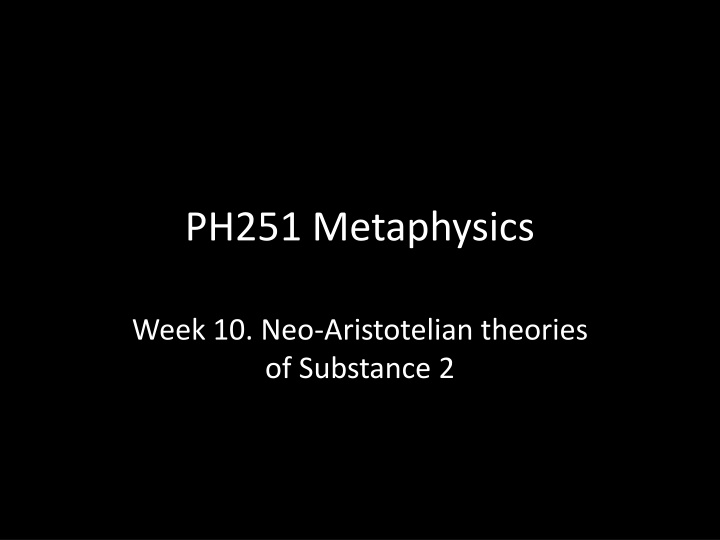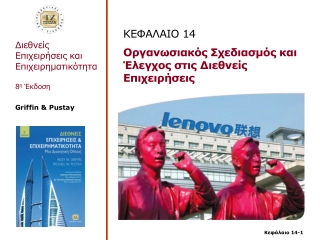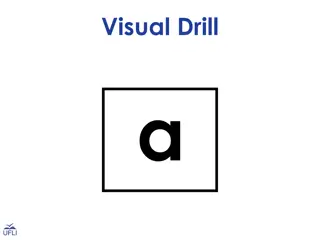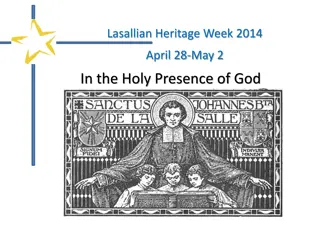
Metaphysics: Neo-Aristotelian Theories of Substance
Explore the intricate concepts of Neo-Aristotelian theories of substance including Hylomorphism, the Special Composition Question, matter, form, essence, and nature. Dive into the essence of substance and the composition of objects based on Aristotle's metaphysical views.
Download Presentation

Please find below an Image/Link to download the presentation.
The content on the website is provided AS IS for your information and personal use only. It may not be sold, licensed, or shared on other websites without obtaining consent from the author. If you encounter any issues during the download, it is possible that the publisher has removed the file from their server.
You are allowed to download the files provided on this website for personal or commercial use, subject to the condition that they are used lawfully. All files are the property of their respective owners.
The content on the website is provided AS IS for your information and personal use only. It may not be sold, licensed, or shared on other websites without obtaining consent from the author.
E N D
Presentation Transcript
PH251 Metaphysics Week 10. Neo-Aristotelian theories of Substance 2
Lecture Plan Revisit SCQ Aristotelian Hylomorphism A contemporary version of hylomorphism A critique of this account
The Special Composition Question Some objects are complexes, and appear to be composed of parts. What conditions must be satisfied in order for a collection of non-overlapping objects to compose a further object? (SCQ) For all xs, the xs compose a y iff (?) Two Radical Answers (1) Unrestricted composition (UC) For any collection of xs, there is a unique object, y, composed of the xs. (2) Nihilism (N) Unless the xs are single, there is never a unique y composed of the xs
The Special Composition Question A Restricted Composition approach would be more consistent with commonsense ontology. But it is difficult to formulate a principled explanation of restriction.
Hylomorphism Aristotle in the Physics and Metaphysics Hyle (matter) morph (form) Certain entities are compounds of matter and form Hylomorphism about primary substances: Concrete particulars are compounds of matter and form
Matter What something is made of (i) The subject that receives form (ii) That which is potentially en-formed There are different conceptions of matter (i) Anhomoemereous parts (head, arms, etc.) (ii) Homoemereous parts (stuffs like flesh, blood, bone)
Form (i) In a basic sense, form is shape or configuration. (ii) But not just literal shape. The form of a thing is how the matter of that thing is structured, arranged or organized. (Think of a plant going through a blender. At the end the sticky gunk is the matter without the form. It lacks the organization and arrangement of a plant.) (iii) The substantial form of a thing is the essence or nature of that thing.
Form (iv) Essence: what it is to be that thing. (e.g. the essence of a cat is what it is to be a cat and this is to be a four-legged animal with such and such capacities and such and such genetic properties..) (v) Nature: The principle of activity and development of that thing; What it is inside a thing that explains the distinctive patterns of change for things of that kind (growth and maturation).
Compounds (i) What is it for form and matter to exist in a compound, to be united together in such a way that an ordinary concrete object exists? (ii) Aristotle uses different vocabulary to describe the unity of matter and form in compounds. (iii) Form inheres in matter. (iv) Matter is receptive of form (matter is capable of receiving form). Form actualizes the potentiality of matter .
Hylomorphism and SCQ (1) The xs are the matter of the object they compose. (2) What explains the unity of a concrete material object is structure or form. Under what conditions do the xs compose something Broadly, the xs compose an object when there is a form of some relevant kind (whether substantial or non-substantial) that unifies the xs
Kathrin Koslicki (2008) The Structure of Objects Mereological hylomorphism : We can understand the notion of a matter- form compound in terms of notions drawn from mereology (the systematic study of part- whole relations).
Koslicki (2008) Proper Parthood x is a proper part of y if and only if the following hold: (i) If x is a part of y then y is not a part of x (ii) If x is a part of y and y is a part of z then x is a part of z (iii) If x is a part of y then there is a z, such that z is a part of y and z is not identical with y.
Koslicki (2008) (2) NAT (Neo-Aristotelian Thesis) The material and formal components which compose a mereologically complex object at time t are at t proper parts of the whole they compose at t. Both form and matter are ingredients of concrete particulars.
Koslicki (2008) Koslicki s claim about Aristotle: The unity of a high-level whole or matter/form compound is, in this sense, borrowed from form: such objects inherit their status as highly unified objects from the forms which act as their principles of unity. (Koslicki, (2008), p.159) But forms are not highly unified. Essences involve a genus and differentia (e.g. rational animal)
Koslicki (2008) (3) Restricted Composition Some objects, m1, mn, compose an object O of kind K, at a time t just in case m1, , mn, satisfy at t the constraints dictated by some formal components, f1 fn, associated with objects of kind K. Koslicki, 2008, A form associated with an object of a certain kind makes certain kinds of requirements on the material entities that are putatively parts of such an object. For something to be a human being requires that there is a particular kind of order and arrangement of the material parts.
Koslicki on Hylomorphism For a whole to be unified is just for its material components to satisfy the structural constraints posed by the formal requirements associated with the kind to which it belongs. To illustrate, with respect to the kind, H2O molecule, a successful case of composition requires two hydrogen atoms and one oxygen atom to enter into the configuration of chemical bonding that is required to form a particular specimen of the kind in question. (Koslicki (2012), unpublished, quoted in Marmadoro, 2013).
Mereological Hylomorphism Special Composition Question Not all entities stand in these law-governed natural relations, relations that flow from the relevant substantial forms. But some do. So there is a rationale for a restricted composition relation.
Mereological Hylomorphism Paradoxes of Material Constitution (i) The statue and the piece of clay are not identical because they do not have all of their parts in common (their formal constituents are different). (NB: We don t have to deny that x and y are identical iff x and y have all the same parts) (ii) Statue and piece of clay are materially coincident in sharing all of their material parts. (iii) The Grounding Problem: What grounds the difference between materially identical things is the non-material, formal parts, of those objects.
Marmadoro (2013) Anna Marmadoro (2013) Aristotelian hylomorphism without reconditioning (1) The interpretation of Aristotle as a mereological hylomorphist is mistaken. (2) Koslicki s reworked version of hylomorphism (as stated in Restricted Composition above) fails.
Aristotle as Mereological Hylomorphist? The syllable, then, is something not only its elements (the vowel and the consonant) but also something else; and the flesh is not only fire and earth or the hot and the cold, but also something else. Since then that something must be either an element or composed of elements, if it is an element the same argument will again apply; for flesh will consist of this and fire and earth and something still further, so that this process will go on to infinity. (1041b11-22) But it would seem that this (the unifier of the elements) is something, and not an element, and that it is the cause which makes this thing flesh and that a syllable And this is the substance (essence) of each thing; for this is the primary cause of its being; which is not an element but a principle. (1041b25-31)
The trouble with reconditioning The restricted composition account is an attempt to explain the unity of substance in terms of the notion of a relation of some kind obtaining between distinct objects (distinct parts). Are the leaves on a tree one? If not, why would the hydrogen and oxygen atoms in H2O be one? Rather, they are a bonded or connected plurality. But connectedness is not unity. Crucially, connectedness does not generate unity when it leaves unchanged the individualities of the connected items. (2013, p.8)
Aristotle on Parts: Homonymy (The parts of a substance) cannot exist if severed from the whole; for it is not a finger in any state that is the finger of a living thing, but the dead finger is a finger only homonymously. (Metaphysics, 1035b24-5) Evidently even of the things that are thought to be substances, most are only potentialities e.g. the parts of animals (for none of them exists separately; and when they are separated, then they too exist, all of them, merely as matter) all the parts must exist only potentially, when they are one and continuous by nature. (1040b5-15)
Aristotle on Parts: Homonymy (i) For ordinary objects to be mereological compounds presupposes that the objects which are their parts can be identified independently of the object. (ii) But the objects which are parts of an object cannot be identified independently of their being parts of an object. (iii) Therefore ordinary objects cannot be understood as mereological compounds. (See Scaltsas (1994) for similar ideas).
Aristotle on the role of substantial form Substantial form is what strips individuality and distinctness away from entities and makes them one. The unification of elements is achieved through their re-identification in terms of the role allotted to them by the substantial form. (2003, p.17) (See section II).
A final Aristotelian thought about SCQ The xs compose a y iff The xs are essentially parts of a y (that is, where their status as parts of a y is determined by the substantial form of the fundamental kind to which y belongs).
Take-home message Hylomorphism provides a framework for addressing SCQ We looked at one attempt to develop hylomorphism to provide an answer to SCQ. While it promises a resolution of SCQ and the paradox of constitution, there are difficulties with this approach. Perhaps Aristotle s work suggests a different kind of hylomorphic strategy in response to SCQ. But this would need to be developed further.






















